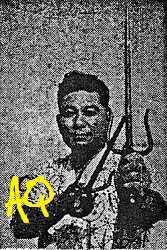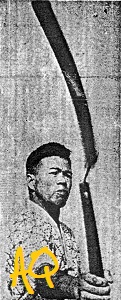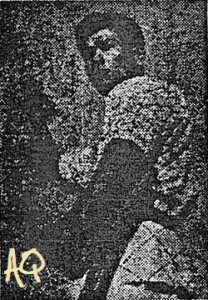This is the translation of a 1955 interview with the Matsubayashi-ryū Kōdōkan headquarter dōjō. It deals with the kobujutsu practiced in this school.
Participants from the Kōdōkan were :
- Nagamine Shōshin (instructor),
- Kushi Jokei (vice-instructor),
- Kyan Shin’ei (Director of the Department of Culture of the Okinawa Faculty Association),
- Yamaguchi Masahiro (assistant teacher),
- Koja Shōshin (assistant teacher), and
- Nakamura Seigi (assistant teacher).
The interview was conducted by the newspaper president Oyadomari and the chief editor Takahara.
Newspaper: By the way, in all of Okinawa‘s kobujutsu weapons are carried, isn’t it?
Kyan Shinei, 1955. Saijutsu.
Kyan Shin’ei: That’s right. It is a method to take action against an armed adversary: However the kobujutsu and weapons of Japan and Okinawa are essentially different. In Japan the weapons used in martial arts (bujutsu) are for the so-called “destruction of life”, for killing. In the case of Okinawa so-called “defensive arts” have been developed. For this reason the weapons used are also peculiar to Okinawa’s kobujutsu.
Newspaper: The weapons themselves tell of this spirit, isn’t it?
Nagamine Shōshin: Certainly, in ancient Japan they were often for a “destruction of life”, for killing. When comparing this with Okinawa, even with the suruchin, or the tinbē and rōchin: these are weapons for defense. Tips and blades have rounded edges.
Newspaper: Where does the bōjutsu of Mr. Koja come from?
Koja Shoshin. Nunchaku.
Koja Shōshin: My teacher is venerable old man Sueyoshi Kōfū, the head (family) of bōjutsu, who is known as Shīshi no Tanmē.
Newspaper: Bōjutsu does not seem to have been very widespread in Okinawa?
Koja Shōshin: That’s right. The bō performed by persons in the rural areas is considered being resplendent or flashy, but this is bō-odori and entirely different from the bōjutsu of Shuri and Naha.
Newspaper: Mr. Yamaguchi’s tuifā are also unusual weapons, isn’t it?
Yamaguchi Masahiro: My tuifā is the art of Matayoshi Shinkō Sensei.
Newspaper: Mr. Kyan, have the sai you use been handed down from olden times?
Yamaguchi Masahiro. Tuifajutsu.
Kyan Shin’ei: No, these here were made after the war. I had old ones which I buried in a cave during the war, but the cave collapsed so they are lost. In the old days, when I visited old families in the rural areas, I saw good sai placed in their alcoves.
Newspaper: Mr. Kyan, from who does your saijutsu come from?
Kyan Shin’ei: I have learned it from a master in Gibu of Shuri.
Newspaper: In Japan exists the jūtte which is very similar to the sai. What kind of combat value do sai have?
Kyan Shin’ei: Well, I do not know much about the jūtte. Sai are built after the form of the human body. The method of using two of them is an advantage over using only one [as in case of the jūtte].
© 2015 – 2020, Andreas Quast. All rights reserved.




